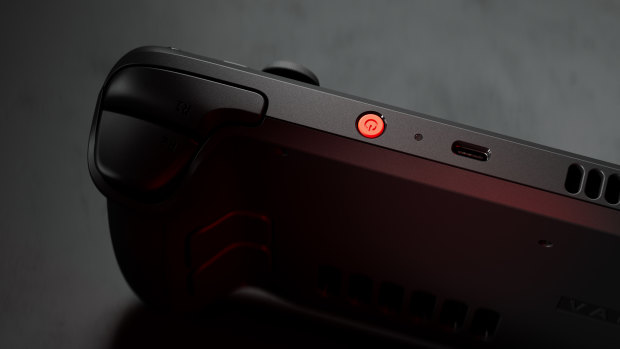It’s difficult to give a sense of what kind of games you can play on Steam Deck because it runs the entire gamut. Some high-end games are simply too demanding for the hardware, while some ancient games are too esoteric to run, but there are thousands that work great, and I’ve played everything from mainstream darlings Baldur’s Gate 3 and Elden Ring to indie sensations Balatro and UFO 50.
From across the last two decades, there are PC classics such as Half Life 2 and the best versions of 2000s and 2010s console games like Tomb Raider. There are massive RPGs like Skyrim, and tiny arcade games like Donut Dodo. Steam’s frequent sales and tailored recommendation engine serves up new favourites all the time, and since Microsoft and Sony are increasingly publishing on Steam you also get access to the likes of Halo: The Master Chief Collection and Spider-man running portably.
These being PC games, the balance of performance and power consumption is often up to you. Pushing a graphically intensive game to run at 60 frames a second could mean you only get two hours of play, while a much simpler game could run at 90 for eight hours. There’s a dedicated button to bring up quick settings, which include options for throttling the performance, so you could eke out up to 12 hours of juice if you really crank things down, and there’s a prominent battery estimate to show the impact of your changes. The display can be set anywhere between 47Hz and 90Hz, meaning you can limit your game to virtually any frame rate and get a clean result (i.e. 20 frames a second would display at 80Hz, 30 at 90Hz), but if this means nothing to you the default works great.

You could put all 10 fingers to work on the Steam Deck if you really wanted to. But just thumbs is good too.Credit:
For controls, the Steam Deck is absolutely stacked. In addition to the d-pad, face buttons and two sticks, there are a pair of touch- and pressure-sensitive pads, and, in addition to the standard shoulder buttons and triggers, there are four grip buttons on the back where your ring and middle fingers naturally sit.
If you’re sticking to games that fully support Xbox-style controllers, everything just works and there is no tinkering necessary. But Valve also provides a comprehensive system for customising controls.
You can use the pads or touchscreen to simulate mouse movement, or map it to one of the sticks. You can move any function to the grip buttons, or set a trigger as a “shift” key that changes what every other button does, meaning you can essentially have a whole keyboard worth of commands at your fingers. There’s also a gyroscope inside, and the sticks have capacitive sensors that report whether your fingers are on them or not, which lets you set up motion-controlled aiming in just about any game. The best part is that you often don’t have to set up any of this yourself; as long as someone somewhere in the world has created and saved a control scheme for the game you’re playing, you can load it up and try it yourself.
Under the hood
A major factor that sets the Steam Deck apart from other handheld PCs is that it runs on a highly customised Linux operating system. Almost all games are designed to run on Windows, but Microsoft’s desktop operating system is an absolute chore to use on a device like this, and it hogs a lot of resources. So Valve uses its own SteamOS, which feels more like a game console, and relies on an emulation layer called Proton to make Windows games work.
For the most part, this is seamless and allows for much more straightforward set-up and daily use, plus some tricks that Windows handhelds can’t match, like being able to put the device in sleep mode and suspend your game for later. But it does mean the Deck has to download a lot of updates, and that some games just don’t work. To give you an idea of what you’re getting before you install or purchase, Valve gives every game a rating based on performance, compatibility, text size and other factors. If a game has a green “verified” tick it should work perfectly. If not, it may require some tinkering. If you’ve been buying PC games on Steam for a long time, Valve has a site you can visit to see how much of your library is verified.
Loading
The store defaults to show only verified games, so newcomers to Steam or those not interested in dealing with technical issues can use the Steam Deck like a standard console. You can even connect it to a TV and Bluetooth controllers. But those who like to get their hands dirty will find plenty of ways to do so.
There are whole communities dedicated to figuring out how to make games run even if Valve has marked them as unplayable, and if you hold the power button you can leave Steam entirely, at which point you have complete access to the machine through Linux. You could plug it into a monitor and keyboard to use it as a desktop PC, or install games from anywhere. The Deck allows you to mark any application as a “non-Steam game”, so you can acquire software in desktop mode (fan games, indie games, emulators, browsers) and then access them in the standard interface right alongside your Steam games.
All this flexibility means more technical users can squeeze extra functionality out of the Deck, but I do think the device remains an excellent experience and pretty good value even for PC novices.
At $900 the Steam Deck OLED is pricier than a console but competitive with a lower-end game-capable PC. For $1050 you can step up to a premium model with a 1TB storage drive (versus 512GB) and an anti-glare etched glass finish. Or, for $650, you can step down to a variant of the original Steam Deck, which has a less impressive screen (LCD, 60Hz) and smaller battery.
Loading
Either way, the premise is the same: PCs’ massive library of video games, smartly reformatted for a handheld console experience, with endless options for play and customisation.
Get news and reviews on technology, gadgets and gaming in our Technology newsletter every Friday. Sign up here.

